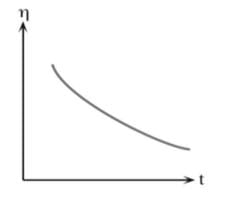Test: Types of Fluids - Mechanical Engineering MCQ
10 Questions MCQ Test Fluid Mechanics for Mechanical Engineering - Test: Types of Fluids
The relation between shear stress Z and velocity gradient  of a fluid is given by
of a fluid is given by  where A and n are constants. If n = 1, what type of fluid will it be?
where A and n are constants. If n = 1, what type of fluid will it be?
The relation between shear stress Z and velocity gradient  of a fluid is given by
of a fluid is given by  where A and n are constants. What type of fluid will it be if n < 1 and n > 1 respectively?
where A and n are constants. What type of fluid will it be if n < 1 and n > 1 respectively?
For what value of flow behaviour index, does the consistency index has a dimension independent of time?
The relation between shear stress Z and velocity gradient of a fluid is given by
+ B where A, n and B are constants.
Which of the following conditions will hold for a Bingham plastic?
The relation between shear stress Z and velocity gradient of a fluid is given by
+ B where A, n and B are constants. Which of the following conditions will hold for a Rheopectic?

The above graph of viscosity vs time depicts which of the following fluids?
(Hint : This fluid is present in inks and paints)
The relation between shear stress Z and velocity gradient of a fluid is given by
where A and n are constants. The graphs are drawn for three values of n. Which one will be the correct relationship between n1, n2 and n3?
What will be the dimension of the flow consistency index for a fluid with a flow behaviour index of -1?
|
56 videos|154 docs|75 tests
|



 of a fluid is given by
of a fluid is given by 












